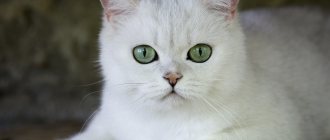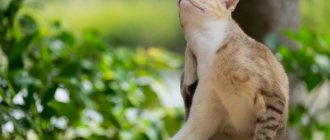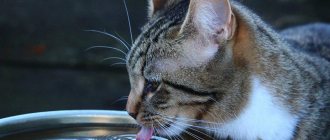How does childbirth occur in cats?
Cats bear offspring for approximately 2.5 months. During one birth, 1-2 kittens are born, as well as 6-7. The process itself takes several hours and consists of several stages. If you are helping your cat give birth, then you need to know how everything usually goes:
- pushing – kittens pass through the birth canal in 4-5 pushing;
- birth - kittens come out in the amniotic sac, less often without it;
- starting breathing - the cat breaks the bubble and licks the born kitten, removing mucus from the respiratory tract;
- rupture of the umbilical cord, eating the placenta - after the kittens, an afterbirth (placenta) comes out, which the cat eats. As many babies are born, so many placens should come out.
Human assistance may be required at each stage of the birth of kittens. When all the babies have come out, all the amniotic sacs have been ruptured, the cat has licked all the babies and they are suckling milk - everything is done. Further assistance will be reduced to proper care of the newborn pet.
To know for sure that all the kittens have come out, it is advisable to first do an ultrasound and count the fetuses. Then there will be no cause for concern if the number of babies born coincides with the number given by the veterinarian.
Threat to the animal
The owner of the animal must understand the threat this pathology of the birth process poses. Retention of the placenta in the birth canal can be complete or partial. If the child's seat has not separated at all, then we are talking about complete detention. If the membranes do not come out completely, then this pathology is called partial retention of the placenta. In both cases, there is a threat of inflammation.
The open birth canal quickly becomes infected with microbes. In this case, putrefactive inflammation of the uterus occurs, since the cervix is not yet closed. An inflamed mother's womb is a good breeding ground for the development of bacteria, which easily penetrate the bloodstream and spread throughout the body, causing septicemia (blood poisoning). The animal becomes severely intoxicated.
Correct care for a woman in labor
In the wild, cats give birth on their own, but in domestic cats, their natural instincts are muted. For this reason, it is desirable that the owner be nearby during childbirth and can provide the necessary assistance in a timely manner. It is especially needed for a cat giving birth for the first time. The pet can only guess what will be required of her. The owner’s task is to act competently and, if necessary, call a veterinarian.
Correct actions with the amniotic sac
If the bubble with the kitten inside is not damaged, if the fetus lies correctly head first, then your help will not be required. You need to intervene in the following cases: - if the bubble is torn, prepare a clean cloth, wrap it around the kitten and gently pull at the next contraction; - if the bladder is torn and the kitten is walking butt, pull without waiting for a contraction, speed is more important so that the baby does not suffocate.
If the cat does not chew the amniotic sac, this must be done for her. You will need sterile scissors. Act quickly - if you wait more than half a minute, the kitten may suffocate.
If the kittens are too big
It is difficult for a cat to give birth to large babies. It will also be difficult for you to remove the kitten; it will slip back into the vagina. If your cat's vulva is dry, lubricate it with Vaseline or lubricant. Proceed as follows: - wait for the next contraction when the baby approaches the vulva; - insert the index finger of a sterile-gloved hand into the vulva a few centimeters and move the skin towards the anus; - as soon as the kitten appears, grab it and move it slightly to help it come out. Determine the intensity of the impact yourself individually.
What to do if a kitten gets stuck
A few hours before birth, kittens take a forward-facing position. But sometimes babies change position or their head is turned to the side, making it difficult to exit the vulva. To help a stuck kitten be born, lubricate the vulva with lubricant or Vaseline and with a sterile gloved hand perform the following manipulations: - carefully insert your finger into the baby’s mouth, if the amniotic sac allows it; — turn the kitten’s head in the right direction so that the cat’s contractions push it further; - press on the cat's perineum at the bottom of the anus - this will cause a contraction, and the baby will not be able to return back.
We do the same if the kitten moves forward with its sacrum - grab it by the paws and guide it along the birth canal.
It happens that for some reason kittens die in the womb. In this case, they will still be born naturally. The cat will go into labor, and if your help is needed, you can act less carefully. It is important that everything is in order with the cat, so if the fetus is stuck, feel free to pull on any part of the body.
Sources of the disease
Feline enteritis, as it is also called, is transmitted from individual to individual. Sources of infection are the feces of sick cats or carriers. Moreover, it is not only the trays themselves that pose a danger. These include scoops and care items, as well as toys. We must not forget that exclusive home maintenance does not exclude the possibility of illness. Caregivers may bring home bits of fur or tiny particles of discharge on their clothes and shoes. If you have several cats, you always need to be on your guard. In the first days after infection, the virus is contained in saliva, so feeding from the same bowl, as well as the love of these animals for licking each other, can lead to dire consequences.
We recommend reading: Dog Suffering from Scabies
But coronavirus in kittens is not so strongly associated with the disease in adults. The fact is that it does not penetrate the placenta from mother to kittens, and it is not in milk. Until 5-7 weeks of age, babies have enough maternal antibodies in their blood, so they are not afraid of such a disease. However, after a month and a half, the level of antibodies in the body begins to drop sharply, and now routine vaccination is necessary, otherwise the likelihood of the baby getting sick increases sharply.
What not to do during childbirth
In the desire to help a giving birth cat, it is important not to harm. There are a number of actions that are prohibited. What you shouldn't do:
- do not press on the stomach, this will cause pain to the cat and harm the kittens inside;
- do not pull the umbilical cord so that it does not break or cause a hernia in the cat;
- do not burst the bladder if the woman in labor is ready to do it herself;
- Do not give injections without your veterinarian's approval and do not use medications to induce normal labor.
- do not use instruments without sterilization to avoid infection;
- Do not take kittens away from your cat immediately after birth.
Metritis.
Metritis, or inflammation of the uterus, usually begins within three days after birth. The cat looks much worse than in the case of a failed placenta. The cat becomes lethargic, ignores the kittens, refuses to eat, experiences extreme thirst, and vomits. Along with fever, purulent, foul-smelling vaginal discharge is present.
READ Rules for flying with animals. What documents are needed to export a dog or cat?
Palpation of the abdomen can cause pain; thickenings can be felt on the uterus. The veterinarian will select appropriate antibiotics for treatment. However, broad-spectrum antibiotics, such as amoxicillin-clavulanic acid or cephalosporins, are usually used as the first stage of treatment. If this treatment fails, an ovariohysterectomy may be required.
Exacerbations of pathological processes after childbirth and bleeding - important to know!
Breeding animals are examined for the presence of pathological processes before mating, and there are very logical reasons for this. Bearing offspring, giving birth and feeding kittens is a serious stress for the cat’s body. For at least 3–4 months, the animal’s immunity will be suppressed, which will give a second wind to any secretly developing pathology.
Most often, owners discover bleeding after birth if the cat suffered from urolithiasis before pregnancy. A small amount of blood in the urine after childbirth can be considered normal if traces of blood disappear within 48 hours. If the bleeding intensifies, and discharge appears only with urine, there is a high risk of damage to the genitourinary system.
With an exacerbation of urolithiasis, in addition to bloody inclusions in the urine, you will find that it is painful for the cat to empty the bladder. Symptoms of acute urolithiasis include:
- Unnatural posture when urinating.
- Strong straining that does not result in urination.
- Screams while pushing.
- Urination in drops - the cat is straining, but there is very little urine.
- A sharp increase in temperature.
- Severe anxiety.
We suggest you read: A cat has a miscarriage, causes, symptoms and what to do
To confirm the diagnosis, you must contact a veterinary clinic and have the animal examined. Without a veterinarian's prescription, you can schedule your pet for an ultrasound of the kidneys and genitourinary system or take a urine test.
As a temporary remedy to relieve an acute condition, herbal veterinary drugs can be used. Carefully read the instructions of the drugs, since some of them are contraindicated when feeding offspring.
Movement of kittens towards the cervix
The process of childbirth begins with the appearance of contractions and dilation of the cervix. Contractions are regular involuntary contractions of the muscles of the uterus. Contractions last from several seconds to several minutes. During childbirth, the strength and frequency of uterine contractions gradually increases. Contractions help kittens move towards the cervix. When contractions begin, the cervix dilates and the kittens can pass into the vagina.
The animal experiences pain during uterine contractions and may meow pitifully. At these moments, the pet really needs the support of its owner.
We suggest you read: A dog has bloody diarrhea: causes, associated symptoms, diagnosis and treatment at home
Insufficient force of uterine contractions is a common cause of complications during childbirth in cats. This may be caused by a lack of the hormone oxytocin or calcium in the pet’s body.
Disease prevention
It’s easier to prevent any misfortune, so from the first day a kitten arrives in your home, be sure to choose a practicing veterinarian for it. Of course, it is very convenient for the collection point to be as close to your home as possible. The work schedule is also important, because help may be needed at any time of the day or night. Today, almost every clinic has it. This is also very convenient in the sense that your animal will not come into contact with carriers of other infections who are brought to the clinic for an appointment. This is extremely important at the time of vaccination, which is the very first and most important means of preventing this viral disease.
They have been looking for a vaccine against coronavirus for quite a long time, this is an unusual infection, so there is nothing surprising about it. As a result of many studies, scientists were able to change the virus in such a way that it became afraid of high temperatures. That is, the cat’s natural body temperature (38.5 - 39) has become destructive for him. At the same time, the temperature in the animal’s nose is lower, approximately 36 degrees. Therefore, the medicine is instilled into the nose, then the modified virus spreads across the mucous membranes, but cannot enter the intestines, since the high temperature kills it. And the body learns to produce antibodies. That is, the best prevention of coronavirus is vaccination. However, this method is not 100% reliable. Even a vaccinated animal can get sick from close and prolonged contact. But the course of the disease will most likely be mild. So the vaccine does not completely eliminate coronavirus, but in most cases it guarantees that your pet will survive it normally and develop its own immunity.
We recommend reading: Deworming Tablets For Dogs Drontal Instructions
Causes of premature abruption of a normally located placenta
Women experience premature expulsion of the placenta in 0.4-1.4% of cases. It can occur both during pregnancy and during childbirth in the first or second stage. Why does placental abruption occur? The reasons for this process are various.
The separation of a child's seat can be caused by disorders in the vascular system . The capillaries of the uterus and placenta may become more fragile and brittle. Because of this, blood flow may be impaired. Similar changes in the female body can occur during gestosis. They are also observed in the presence of certain diseases: cardiovascular pathology, hypertension, kidney disease, obesity, diabetes, etc.
The threat of placental abruption can come from inflammatory, degenerative and other pathological processes occurring in the baby's place and uterus. Disturbances can be observed with uterine fibroids, malformations, and post-maturity.
Bad habits predispose to premature expulsion of the placenta : excessive consumption of drinks containing alcohol, addiction to cigarettes and drugs. The situation may worsen with anemia (anemia, decreased number of red blood cells, low hemoglobin).
Most often, symptoms of placental abruption in the early stages of pregnancy or later are observed in women for whom the upcoming birth is not the first . The reason for this lies in changes in the uterine mucosa.
The most rare cases of placental abruption are due to autoimmune conditions , in which the female body produces antibodies to its own cells. This can be observed with a disease such as lupus erythematosus.
Allergy to drug therapy is another reason for placental abruption in late or early stages. Typically, pregnant women experience an allergic reaction when transfusion of donor blood and its components, or administration of protein solutions.
Complications can result from abdominal trauma caused by a fall, blow, or accident. Placental abruption can also be facilitated by sudden changes in blood pressure that occur during stress and other neuropsychic influences.
Retention of placenta
Childbirth in animals ends with the separation of the membranes (afterbirth).
It is customary to talk about the retention of the placenta when it has not separated in mares after 35 minutes, in cows - after 10-12 hours. in sheep and goats - after 5 hours, in pigs, dogs, cats and rabbits - 3 hours after birth. Retention of the placenta occurs in all animals, but due to the unique structure of the placenta and the relationship between its fetal and maternal parts, it is more often observed in cows. Every abortion in an animal is accompanied by retained placenta. Depending on whether all the membranes come out of the animal’s genital tract, retention is complete - when all the membranes remain in the birth canal and incomplete (partial), when separate sections of the chorion or single placentas remain in the uterine cavity (in cows).
Cause. They are divided into immediate and predisposing.
Immediate reasons for retained placenta:
- Atony of the uterus and insufficient tension of afterbirth contractions.
- Fusion of the fetal part of the placenta with the maternal part due to inflammatory processes in the endometrium or chorion of the fetus.
Among the predisposing factors, living conditions and lack of exercise are of great importance. In all species of animals that do not take walks during pregnancy, retention of the placenta is widespread. This is confirmed by the mass detention of placenta in cows during the winter - stall period.
Predispose to retention of the placenta by all those factors that cause a decrease in the tone of the muscles of the uterus and the entire body of women in labor: exhaustion, obesity, lack of minerals in the diet. The retention of the placenta in highly productive cows is especially affected by their highly concentrated type of feeding, the lack of vitamins and minerals aggravated by the unfavorable microclimate in the barnyard.
Twins, as well as an overly large fetus, causing stretching of the uterus and a decrease in the strength of uterine contractions. Exhausting, difficult childbirth with damage to the birth canal. The retention of the placenta can be of an infectious nature (brucellosis, yersiniosis, etc.). The retention of the placenta is facilitated by a profound metabolic disorder in the animal.
Signs. When the placenta is completely retained, a red or gray-red strand is visible from the external genitalia. In a cow, the surface (placenta) is lumpy, while in a mare it is velvety. Sometimes it happens that only flaps of the urinary and amniotic membranes without vessels are visible from the outside - in the form of gray-white films. If an animal has severe uterine atony, then we do not see the membranes from the outside, because
they are located in the uterus itself. To establish incomplete retention of the placenta, it is necessary to conduct a thorough examination. In practice, this circumstance is completely ignored by veterinarians. In the best cases, at the request of the attendants, veterinarians conduct an inspection of the uterine cavity for the presence or absence of an afterbirth or its individual parts.
Flow. Retained placenta in mares is accompanied by severe general illness. Within a few hours after giving birth, mares experience general depression, body temperature rises, breathing quickens, the mare groans and strains. If the necessary veterinary care is not provided in a timely manner, the mare will die from sepsis within 2-3 days.
In cows, when the placenta is completely retained, a significant part of the membranes is visible from the external genitalia, sometimes reaching the hock joints. When exposed to unfavorable conditions in a barnyard, fallen parts of the placenta, especially in the summer, begin to quickly decompose, spreading an unpleasant putrid odor around them.
Microorganisms penetrate through the afterbirth into the uterine cavity, where there is a large amount of disintegrating semi-liquid bloody masses. As a result of the rapid development of pathogenic microflora in decomposing tissues, a rapid process of formation of toxic substances occurs, followed by their absorption into the blood, which leads to general intoxication of the body.
When the placenta is partially delayed, decomposition of the placenta begins in the uterus on days 4-5. Decomposition is manifested by signs of purulent-catarrhal endometritis. A large amount of pus mixed with mucus and grayish crumb-like masses is released from the genital organs.
Retention of the placenta if medical assistance is not provided in a timely manner leads to chronic endometritis and often to infertility.
In sheep, retention of the placenta is rarely observed. In pigs and goats, retained placenta often leads to septicopyemia. Retaining the placenta in dogs is especially dangerous, because... instantly complicated by sepsis and death of the dog.
Treatment. Treatment started early gives better results than delayed treatment. It must be borne in mind that when the placenta remains in the atonic uterus for a long time, swelling of the caruncles occurs, and pathogenic microflora rapidly multiplies with all the ensuing consequences.
Treatment should be carried out comprehensively, systematically and aimed at increasing the body's resistance, strengthening contractions of the uterine muscles and preventing the proliferation of pathogenic microorganisms.
After the time period necessary for removing the placenta from the uterus has passed, they begin conservative methods of separation of the placenta (administration of drugs that cause contraction of the uterine muscles - sinestrol, pituitrin, oxytocin, etc., according to the instructions for the use of these drugs), they can be used three times, after every 6 hours.
To increase the overall tone of the body and for the purpose of detoxification, 250-300 ml of a 40% glucose solution and 100-150 ml of a 10% calcium chloride solution are administered intravenously. Inside, the cow is given 400-500g dissolved in 1 liter of hot water. sugar or honey. To speed up contraction of the uterus and prevent decomposition of the placenta, foaming medicinal substances (metromax, exuter, etc.) are administered intrauterinely.
If conservative methods - separation of the placenta do not give a positive result, proceed to surgical separation of the placenta, after which antibacterial drugs in the form of suppositories, etc. are introduced into the uterine cavity.
In case of poor general condition of the animal, elevated body temperature, refusal to feed and other disorders indicating the onset of intoxication of the body and the development of postpartum sepsis, you must immediately begin intensive treatment of the sick animal (antibiotic therapy, intravenous administration of glucose with calcium chloride, vitamin therapy)
In dogs, the uterus is first massaged through the abdominal walls from the chest to the pelvis. Oxytocin is injected subcutaneously (small dogs 0.2-0.3 ml, medium 0.4-0.6, large 0.8-1 ml) 1% oil solution of sinestrol (small 0.3 ml, medium 0.5, large 0.7-0.ml) intravenous or intramuscular calcium glucanate, intravenous or subcutaneous - glucose, from vitamin preparations - B1, B12.
Prevention. It is based on the prevention of uterine atony and fusion of the chorionic villi with the uterine coruncles. Why should animals receive a complete, nutritionally balanced diet? Regular active exercise, correct and timely launch of dry cows, and measures aimed at preventing abortions.
In farms with a weak food supply and the impossibility of providing adequate feeding, it is recommended to administer intramuscular tetravit and trivitamin to cows three times before calving every 10 days - in a dose of 10 ml. If the sugar-protein ratio is disturbed, a good result is obtained by intraperitoneal administration 15-30 days before the expected calving of 500 ml of a 40% glucose solution from a Janet syringe with a Bobrov needle.
We suggest you read: Seborrhea dandruff in cats and kittens
In order to prevent retention of the placenta, our grandmothers fed colostrum to the cow after calving, gave raw testicles from their hens, and also fed granulated sugar in the swill. These recipes remain relevant today. Today, scientists have finalized these recipes for owners of private household plots, peasant farms and industrial livestock farming, which are now called energy workers.
Most owners of private household plots and peasant farms today prefer ready-made factory-made energy drinks - these are powders for preparing swill, as well as liquids. One of these powders is Vitamis Energy, which contains vitamins A, D, E, vitamin K 3, B1, B2, B3, B4, B5, B6, B12 and vitamin H, microelements - copper, iodine, cobalt, selenium, manganese, zinc, and magnesium.
This energy drink contains glucose and calcium propionate as an energy source; it contains electrolytes, a vitamin-mineral mixture, probiotics and a sweetener. This energy drink is given to a cow after calving, when she has licked her calf for 15 minutes. Before use, dissolve this energy drink (1 kg) in 20-40 liters of warm water. Most fresh cows drink this kind of swill on their own; some have to be given it from a plastic bottle.
Propyl glycol is used as a liquid energy drink in livestock farming. Dose 300-500ml. Used both in pure form and with water.
Due to the difficulty of balancing a cow's feeding ration in terms of vitamins and microelements, owners of private household plots and peasant farms are recommended to introduce premixes for cattle into the feeding ration.
When helping with childbirth, the owner should pay attention to how many afterbirths the cat has. To do this, it is necessary to count the kittens and the delivered placentas. Their number should be equal. The baby's place emerges from the birth canal after each kitten is born.











